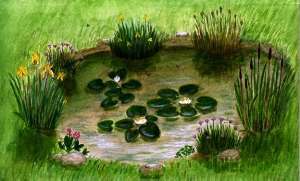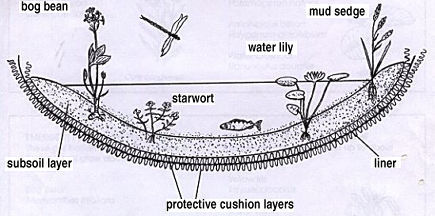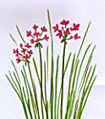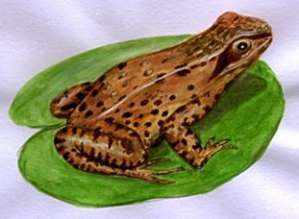Introduction
 Water is essential for all life and the addition of a pond to a garden will attract all sorts of wildlife. As well as providing a much-needed habitat for Britain's increasingly rare pond-life, the water in a shallow-edged pond will be appreciated by bird and mammal visitors to the garden.
Water is essential for all life and the addition of a pond to a garden will attract all sorts of wildlife. As well as providing a much-needed habitat for Britain's increasingly rare pond-life, the water in a shallow-edged pond will be appreciated by bird and mammal visitors to the garden.
The Site
Decide on a suitable site for your pond. It is best to choose a level, light, sunny position away from overhanging trees. A wet hollow is to be avoided - it may flood during wet weather. A south-west facing corner with some nearby shrubbery would be ideal. Mown or paved access to one or more parts of the pond will enable you to watch the pond-life easily. Nearby vegetation provides shelter for shy animals coming down to the water and for the young amphibians when they leave the pond.
Shape and Dig
When you have chosen the site, mark out the shape of the pond with canes and string. Make the pond as big as space will allow. Next comes the hard work - digging! The edges of the pond should be very shallow, providing a habitat for wetland water plants and allowing animals to climb in and out of the water. The deepest part of the pond should be no less than 700 mm - this allows the pond-life to survive under the thickest sheet of ice in winter. The ideal shape for the hole is a gently sloping saucer. Dig at least 150 mm deeper all over than the depth you eventually want the pond to be. For example, if the deepest part in the middle is to be 700 mm, then dig down to 850 mm. Also dig the ground 150 mm for half a metre all round the edge of the pond (this is so you can anchor the overlap of the liner). Remember to shape the hole so it has gently sloping contours - this makes the liner easier to fit over the shape.
Cushion Layer
When you have finished digging, smooth over the surface, removing any sharp stones etc. Next, collect together lots of soft material such as newspapers, pieces of carpet or sheets of damp cardboard; lay a 50 mm cushioning layer all over the surface. Extend this protection over the edge of the hole - the edges are the most likely areas to get punctured.
The Lining
The best way of waterproofing your pond is to line it with a flexible sheet. This may range from 1000 gauge black polythene to the most expensive butyl lining. The latter is the best and it lasts for at least 50 years. Polythene liners must be protected from the sun's ultraviolet rays which make them brittle and this can cause cracking and leaking within a summer (see step 5). Make sure you buy a large enough sheet of liner to allow for plenty of overlap. Stretch the liner over the hole and ease it into place under its own weight. Put smooth-based heavy objects e.g. bricks, on the edges to weigh them down.
Protection
The lining now needs to be covered with a protective layer similar to the one already below it i.e. newspapers, carpets, etc. (Note: avoid using red carpet - the dye may come out, turning the water bright red!). This covering protects the lining from the sun. Now cover this layer with an overlayer (about 100 mm) of subsoil or gravel - you can use some of the soil you have dug out. Remove the weights from around the liner, securely anchoring it down under 150 mm of soil all around the edge.
Filling
Place a piece of polythene in the deepest part of the hole and lay a hose pipe on top of it. Let the water slowly trickle in over the polythene. In this way you should be able to fill the pond without stirring up the soil and making a mud bath!

Stocking Your Pond - Plants
The best time to put plants into the pond is April or early May. Plant straight into the layer of soil. Choose native species. Firstly you will need submerged 'oxygenators'. You can buy these from garden centres but it is far cheaper to beg some from another pond owner (don't take any from a wild pond). Just two or three small clumps, anchored down with a half-brick, will soon start growing well. Milfoil and water starwort are good native 'oxygenators'; try to avoid Canadian pondweed - it grows like wildfire and quickly takes over a pond!
Other plants to introduce are those which have their roots in the bottom and their leaves and flowers floating on the surface e.g. water lilies.
In the shallows, emergents may be grown in the different depths; these are valuable for sheltering wildlife as well as looking attractive.
Below are some tables of native plants suitable for a garden pond:-
 Submerged Aquatic Plants
Submerged Aquatic Plants
These provide oxygen and shelter for pond animals
Spiked water milfoil Myriophyllum spicatum
Hornwort Ceratophyllum demersum
Curled pondweed Potamogeton crispus
Water starwort Callitriche Spp
 Bottom - Rooted & Floating-Leaved Plants
Bottom - Rooted & Floating-Leaved Plants
White water lily Nymphaea alba
Yellow water lily Nymphaea lutea
Fringed water lily Nymphoides peltata
Broad-leaved pond weed Potamogeton natans
Amphibious bistort Polygonum amphibium
Water crowfoot Ranunculus aquatilis
(only suitable for large ponds)

Emergent Plants - Deeper Water
These are bottom-rooted; the leaves & flower stems grow above the water surface
Bog bean Menyanthes trifoliata
Flowering rush Butomus umbellatus
Burr reed Spargahium erectum
Lesser reedmace Typha latifolia
 Emergent Plants - Marsh Zone
Emergent Plants - Marsh Zone
These can cope with water up to about 150 mm deep
Yellow iris ....... Iris pseudacorus
Water mint Mentha aquatica
Water plantain Alisma plantago - aquatica
Brooklime Veronica beccabunga
Water forget-me-not Myosotis scorpioides
Lesser spearwort Ranunculus flammula
Mud sedge. Carex limosa
 Marsh Plants - Bankside Zone
Marsh Plants - Bankside Zone
These like damp places but are not true water plants
Codlins and cream or Hairy willowherb Epilobium hirsutum
Marsh marigold Caltha palustris
Marsh woundwort Stachys palustris
Bugle Ajuga reptans
Creeping jenny Lysimahia nummularia
Purple loosestrife Lythrum salicaria
Meadowsweet Filipendula ulmaria
 Salad burnet Sanguisorba minor
Salad burnet Sanguisorba minor
Ragged robin Lychnis flos-cuculi
Meadow buttercup Ranunculus acris
Hemp agrimony Eupatorium cannabinum
Stocking Your Pond - Animals
 Great pond snail
Great pond snail
Your newly-made pond will act like a magnet to all sorts of pond-life. Very few animals need to be specially introduced. Dragonflies, pond skaters and beetles arrive on the wing amazingly quickly. Try to resist the temptation to introduce animals for about a year - it's fun to wait and see what turns up!
If you have obtained water plants from another pond for stocking yours, you will probably find that several small animals came with them. The jelly-like snails' eggs almost certainly arrive this way and you could beg a few adult snails from a friend's pond. Snails are essential if you want clear water - they eat the algae which grows quickly in a new, still-unbalanced pond.
In a new pond there is a shortage of dead plant material -
essential food for tiny aquatic animals. A good way of rectifying this problem is to float chopped-up lengths of clean straw on a pond's surface. These sink to the bottom after a day or two and before long the invertebrates will increase quite dramatically.
 Common Frog
Common Frog
Frogs, toads and newts may find their own way to your new pond. It is useless, and cruel, to transplant adults - they will try to return to the pond they were born in. Don't take the spawn from a wild pond - beg it from someone else's garden pond.
Goldfish are bad news for natural inhabitants - they eat them! If you like the idea of fish and your pond is fairly large, then introduce a few sticklebacks.
Pond Management
If the summer weather is very hot and dry you may find that your pond loses a lot of water by evaporation. Topping up with tap water can cause problems. The nutrients in the tap water encourage the rapid growth of 'algal bloom' - a green slime. This looks unattractive, uses up a lot of oxygen and can cut out the sunlight too. Don't use chemicals to kill this 'blanket weed'. The best thing to do is to rake it out. Remove some of the other plants too, if they are threatening to take over. When you rake out plants, leave them lying by the pond edge for a day or two before disposing of them; this allows any trapped animals to crawl back into the water. Remember that having a large population of water snails is a great help - snails munch their way through much of the algae as it grows.
You will probably be amazed just how quickly a brand new pond matures into an established habitat. It is fascinating to watch your pond improve as time goes by and both you and the wildlife you are helping will derive much enjoyment from the new habitat you have created.

 Water is essential for all life and the addition of a pond to a garden will attract all sorts of wildlife. As well as providing a much-needed habitat for Britain's increasingly rare pond-life, the water in a shallow-edged pond will be appreciated by bird and mammal visitors to the garden.
Water is essential for all life and the addition of a pond to a garden will attract all sorts of wildlife. As well as providing a much-needed habitat for Britain's increasingly rare pond-life, the water in a shallow-edged pond will be appreciated by bird and mammal visitors to the garden.

 Submerged Aquatic Plants
Submerged Aquatic Plants Bottom - Rooted & Floating-Leaved Plants
Bottom - Rooted & Floating-Leaved Plants
 Emergent Plants - Marsh Zone
Emergent Plants - Marsh Zone Marsh Plants - Bankside Zone
Marsh Plants - Bankside Zone Salad burnet Sanguisorba minor
Salad burnet Sanguisorba minor Great pond snail
Great pond snail Common Frog
Common Frog
